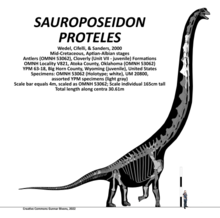| Sauroposeidon | |
|---|---|

| |
| Skeletal reconstruction of the holotype of S. proteles | |
| Scientific classification | |
| Domain: | Eukaryota |
| Kingdom: | Animalia |
| Phylum: | Chordata |
| Clade: | Dinosauria |
| Clade: | Saurischia |
| Clade: | †Sauropodomorpha |
| Clade: | †Sauropoda |
| Clade: | †Macronaria |
| Clade: | †Somphospondyli |
| Genus: | †Sauroposeidon Wedel, Cifelli & Sanders, 2000 |
| Species: | †S. proteles
|
| Binomial name | |
| †Sauroposeidon proteles Wedel, Cifelli & Sanders, 2000
| |
| Synonyms | |
| |
Sauroposeidon (/ˌsɔːroʊpoʊˈsaɪdən/ SOR-o-po-SY-dən; meaning "lizard earthquake god", after the Greek god Poseidon[3][4]) is a genus of sauropod dinosaur known from several incomplete specimens including a bone bed and fossilized trackways that have been found in the U.S. states of Oklahoma, Wyoming, and Texas.
The fossils were found in rocks dating from near the end of the Early Cretaceous (Aptian–early Albian), from about 113 to 110 million years ago, a time when sauropod diversity in North America had greatly diminished. It was the last known North American sauropod prior to an absence of the group on the continent of roughly 40 million years that ended with the appearance of Alamosaurus during the Maastrichtian.
While the holotype remains were initially discovered in 1994, due to their unexpected age and unusual size they were initially misclassified as pieces of petrified wood. A more detailed analysis in 1999 revealed their true nature which resulted in a minor media frenzy, and formal publication of the find the following year.[5]
Paleoecological analysis indicates that Sauroposeidon lived on the shores of the Gulf of Mexico, in a river delta. Extrapolations based on the more completely known Brachiosaurus indicate that the head of Sauroposeidon could reach 16.5–18 m (54–59 ft) in height with its neck extended, which would make it one of the tallest known dinosaurs. With an estimated length of 27–34 m (89–112 ft) and a mass of 40–60 t (44–66 short tons), it also ranks among the longest and heaviest. However, this animal may not be as closely related to Brachiosaurus as previously thought, so these estimates may be inaccurate.
While initially described as a brachiosaurid closely related to Brachiosaurus and Giraffatitan, the discovery of additional remains in the Cloverly Formation of Wyoming suggested that it was in fact more closely related to the titanosaurs, in the group Somphospondyli. Analysis of these remains and comparison with others from Texas supported this conclusion, and demonstrated that the more completely known sauropods from the Twin Mountains Formation (including a partial skull and fossil trackways) previously named Paluxysaurus jonesi also belonged to Sauroposeidon.[6] It is the state dinosaur of Texas.[7]
- ^ Holtz, T. R. (2011). "Dinosaurs: The Most Complete, Up-to-Date Encyclopedia for Dinosaur Lovers of All Ages, Winter 2011 Appendix" (PDF). Retrieved September 21, 2022.
- ^ Brochu, C.A.; Long, J.; McHenry, C.; Scanlon, J.D.; Willis, P. (2002). Brett-Surman, M.K. (ed.). A Guide to Dinosaurs. San Francisco, CA: Fog City Press. pp. 112–205. ISBN 1-877019-12-7.
- ^ Wedel, Mathew J.; Cifelli, Richard L. (Summer 2005). "Sauroposeidon: Oklahoma's Native Giant" (PDF). Oklahoma Geology Notes. 65 (2): 40–57. Archived from the original (PDF) on June 21, 2007.
- ^ According to Wedel et al. (2005), the etymology of the name is based on Poseidon's association with earthquakes, not the sea.
- ^ Wedel, Mathew J.; Cifelli, R. L.; Sanders, R.. K. (2000). "Osteology, paleobiology, and relationships of the sauropod dinosaur Sauroposeidon" (PDF). Acta Palaeontologica Polonica. 45: 343–388. S2CID 59141243. Archived from the original (PDF) on June 26, 2020.
- ^ D'Emic, M.D.; Foreman, B.Z. (2012). "The beginning of the sauropod dinosaur hiatus in North America: insights from the Lower Cretaceous Cloverly Formation of Wyoming". Journal of Vertebrate Paleontology. 32 (4): 883–902. Bibcode:2012JVPal..32..883D. doi:10.1080/02724634.2012.671204. S2CID 128486488.
- ^ "Texas State Symbols". Texas State Legislature. Retrieved December 13, 2017.